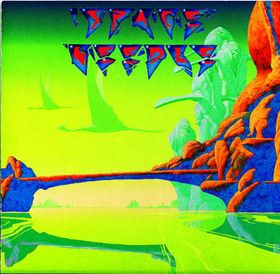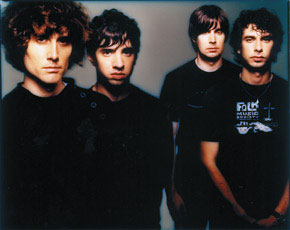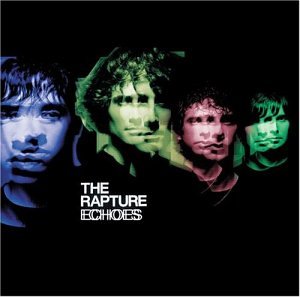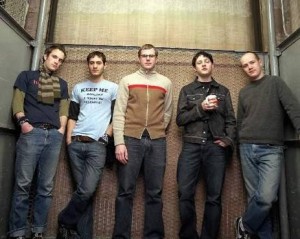FOREWORD: Space Needle composer Jud Ehrbar never got the respect he deserved as one of the ‘90s most adventurous progressive rock avatars. But due to his permanent New York underground stature, I was able to speak with him on several occasions before and after New York gigs. I found his cosmic escapades riveting. But after ‘97s The Moray Eel Eat The Space Needle, Ehrbar settled into a backup role as drummer in band mate Anders Parker’s solo project during the next decade. This article originally appeared in HITS magazine.
(I’ve also included an Aquarian Weekly piece that follows.)
Despite the deceiving Space Needle moniker, this trio does not live in Seattle, where the famous pinhead monument of the same name reaches skyward. Instead, Space Needle features Northport, Long Island natives Jud Ehrbar (arrangements-drums) and Jeff Gatland (guitar) with upstate New York pal, Anders Parker (guitar).
Formed during stints in Poughkeepsie and Providence, this valiant trio plays the gamut from sweet pop ballads to freeform instrumental excursions. They rely on drifting, extended improvisations at live shows, mesmerizing awed fans with their musical ability and cohesion.
In ’95, Space Needle dropped the sophisticated requiem, Voyager, what some call the Dark Side Of The Moon of modern rock. With the recent release of the moodily kaleidoscopic The Moray Eel Eats The Space Needle, they move further into a sophisticated noisy Jazz direction. But do not be scared off, fans of ardent pop. The elegant “Never Lonely Alone” and the gorgeous “Love Left Us Strangers” are tenderly affectionate ballads that leave Celine Dion, Mariah Carey, and Toni Braxton crying on their ill-deserved Grammys.
Ehrbar’s musical inspirations include Eno’s Another Green World, Velvet Underground, and ‘70s prog-rock. He’s a musical chameleon able to fit into any popular style he desires. On the night of this ’97 interview, he was backing up the band, Long River Train, at lower Manhattan’s Pink Pony while band mate Anders Parker just happened to play an introspective acoustic set right afterwards. By the way, along with Anders’ brother John, who I’ve shared a few cocktails with in the past, Ehrbar and Parker also coexist in delectable indie pop band, Varnaline.
Since Space Needle’s mind-expanding experiments are sometimes difficult to grasp, have you ever encountered much jeering while on tour?
JUD: We had this guy from Little Rock, Arkansas, who must’ve surely disliked us. I had my drums set up near the foot of the stage and this redneck stood two feet in front of me and held his middle finger out for a few minutes. I just continued playing.
Rednecks are probably lost when you go beyond the third chord. What was your most confounding song on The Moray Eel?
JUD: The last track, “One Kind Of Lullaby.” We had been doing it live, playing it heavy and bombastic. Jeff (Gatland) said it sounded like a bad U2 song. So we had to reinvent it. It took several tries to figure out a better arrangement.
Has Space Needle ever been completely lost during one of its improvisational jams?
JUD: That can be a problem. But it’s also when we sometimes create our best songs. It’s really horrible and frustrating to be flopping through. It’s the worst feeling being onstage and sucking – which we’ve definitely done.
Has Space Needle played any real sleazy dives?
JUD: Well. Sometimes it’s hard to differentiate between the shows we have and the clubs we play. We love New York clubs such as Mercury Lounge and Brownies, but… Hey, Anders, what was the name of that one place in the Midwest?
ANDERS: Oh, it was in Omaha. Either the Iron Cage or the Cog Shop. They had shitty flat beer and there was a cold straight-edge punk crowd. We went over quite poorly as you’d expect. And the sound system was bad. But the people working there were very nice.
What’s the toughest part of touring?
JUD: We all get along well. But we’re usually drinking quite a bit and it dulls the nerves. We’ve had some equipment problems. We’ll show up with broken equipment after doing a crazy show the night before. That happens when you pack up drunk. The next day you do a sound check and it’s like, ‘Jesus Christ, what happened to my drum kit?’ Sometimes we’ll show up and our guitars will be broken.
What will be the singles from Moray Eel?
JUD: “Never Lonely Alone” backed with a 10″ remix of “Love Left Us Strangers” by Paul Riordan. He’s from L.A. and was an engineer for the Geto Boys and Scarface. There’s even a demo version Anders did of “One Kind Of Lullaby.” I did “Never Lonely Alone” by myself on four-track. I didn’t try to make it as slick as “Love Left Us Strangers,” which we made with every intention of getting airplay. “Love Left Us Strangers” is a look at a failed relationship that was doomed from the start while on “Never Lonely Alone,” I wrote from the point of view of somebody who is a loner that goes to movies by himself. It could never be about me. At the time, I realized listeners might get tired just hearing me relate my own personal experiences.
What artists have you been listening to recently?
JUD: While I’m not deeply immersed in it, there are a few Bay Area DJ’s sampling things that I enjoy. Dr. Octagon, DJ Shadow, and even Goldie have put out some refreshing stuff. There are also some great songwriters not necessarily from the indie rock scene which I really like, such as Joe Henry and Freedy Johnston.
How’d you get together with Sean Thompson in Long River Train?
JUD: I was just filling in on tour. But I’ve played with Sean up in Poughkeepsie when Anders and his brother, John, were starting out with me. We’ve been friends for some time.
—————————————————————-
 SPACE NEEDLE: THE AQUARIAN PIECE
SPACE NEEDLE: THE AQUARIAN PIECE
Space Needle incorporate the avant-garde post-rock talents of percussionist-arranger Jud Ehrbar and guitarist Jeff Gatland, Northport, Long Island natives partnered with Varnaline frontman-guitarist Anders Parker. Together, this progressive trio rarely plays live. And when they do, instead of merely rehashing track from its Eno-esque space rock debut, Voyager, or shimmering sophomore set, The Moray Eel Eats The Space Needle, they either remit droning electronic orchestrations or blurry Jazz-related excursions.
“When I first started recording, I had no equipment. It was frustrating back then. I had all these expansive ideas but I couldn’t put them down. Maybe some of what we do is over people’s heads, but we have a fan base who know songs like “Where The Fuck’s My Wallet?” (a fascinatingly grueling 13-minute lead track on Moray Eel) from hearing it at earlier dates. If we worry about intimidating audiences, then it defeats the point of what we’re attempting to do,” Ehrbar explains as we sit on a couch downstairs at Knitting Factory before Space Needle’s alluring 45-minute set.
Whether or nor it’s risky to put an extended instrumental jam in the premier spot on an album is hardly the issue though. At the core of Moray Eel lies two tenderly crafted ballads concerning broken relationships. The warmly impassioned “Never Lonely Alone” fits contemporary radio like a ‘90s version of “Every Breath You Take.” And the synth-based soft-toned “Love Left Us Strangers” is one of the better moody contemplation’s in recent years. When Space Needle spruce up guitar fuzz and apply blurry sonics, they come up with the delicately murmured “Old Spice.”
When asked what the trio may perform on this cold January night at the Kntting Factory, Ehrbar looks up and frankly states, “I’m honestly not sure yet.”
Ehrbar’s cosmically esoteric material seems influenced by the Mahavihnu Orchestra and other Jazz-rock pioneers. But he’s also intrigued by ‘70s prog-rock legends, King Crimson, Yes, and Pink Floyd. He even recruited Yes album designer Roger Dean to draw the cover for Moray Eel.
Happily, Ehrbar’s not confined by the art for art’s sake gothic indulgences and lyrical pretensions which led to the downfall of prog-rock. Instead, he’s interested in the idiosyncratic introspection’s and eerie settings the relic style once relied on at its base.
Live, Space Needle break down the barriers separating noise from music. Lingering moods fluctuate unexpectedly and abandon formal patterns, resulting in enigmatically beautiful sounds.
As Space Needle slowly break into an improvised expedition so unstructured and atmospheric it took a few minutes to realize they weren’t just warming up, the crowd remained awestruck and mesmerized. The addition of Ithaca, New York violinist Max Buckholtz gives each instrumental a delicate tension. Then Buckholtz sat with his legs crossed and eyes shut at the edge of the stage, meditating while Parker and Gatland applied sonic guitars to Ehrbar’s hypnotic-to-frenetic percussion.
On Moray Eel, Buckholtz’s icy glissando battles back clustered drums on the teasing “Hot For Krishna.” And his galactic digressions give the exotic strip tease “Hyapatia Lee” proper soft porn imagery. His drifting passages somehow recall classically trained violinist Jean Luc Ponty’s celestial ‘70s solo recordings.
“We’re not good enough to be a Jazz combo so we do our best to make use of what instruments and skills we do have, “Ehrbar humbly and honestly insists. “Soemwhere down the road I’d like to maybe do soundtrack music. I think the Reservoir album I made by myself last year touched upon some of those ideas.”


